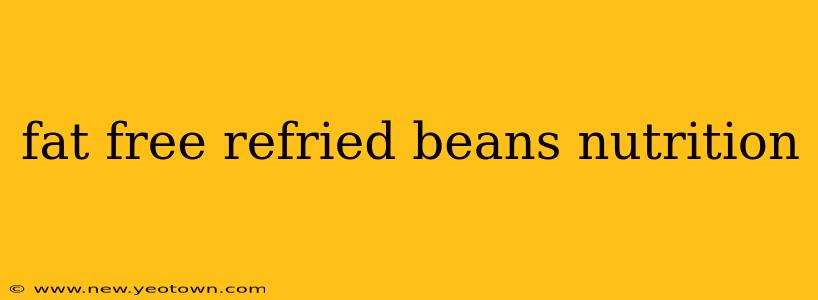Let's be honest, refried beans are a comfort food staple. That creamy texture, the savory flavor… it’s hard to resist! But the traditional recipe often packs a hefty dose of fat. That's where fat-free refried beans step in, offering a healthier twist on this beloved dish. But are they truly a nutritional powerhouse? Let's explore the nutritional profile, address common concerns, and uncover some delicious ways to enjoy them.
What are Fat-Free Refried Beans?
Fat-free refried beans are essentially a processed version of pinto beans (though other beans can be used), where the beans are cooked, mashed, and then often mixed with broth or water and seasonings to achieve that signature creamy consistency. The key difference is the absence of added fat, unlike traditional refried beans which often contain lard or oil. This modification significantly impacts their nutritional content, making them a potentially healthier option for those watching their fat intake.
Are Fat-Free Refried Beans Healthy?
The healthiness of fat-free refried beans depends on several factors, including the brand and any added ingredients. While they're lower in fat than their traditional counterparts, they're still a good source of fiber, protein, and certain vitamins and minerals. However, they can also be higher in sodium, so it's important to check the nutrition label carefully and choose low-sodium options whenever possible.
How Many Calories are in Fat-Free Refried Beans?
Calorie counts vary by brand and serving size, so always check the label. Generally, a half-cup serving of fat-free refried beans contains around 100-120 calories. This is significantly lower than traditional refried beans, which can have double or even triple the calories due to added fat.
What Vitamins and Minerals are in Fat-Free Refried Beans?
Fat-free refried beans are a decent source of several essential nutrients:
- Fiber: Crucial for digestive health and regulating blood sugar.
- Protein: Contributes to building and repairing tissues.
- Iron: Essential for red blood cell production.
- Folate: Important for cell growth and development.
- Potassium: Supports healthy blood pressure.
However, it's important to note that the nutrient content can vary depending on the brand and processing methods.
Are Fat-Free Refried Beans High in Sodium?
This is a crucial point. Many brands of fat-free refried beans are high in sodium, which can be detrimental to heart health. Always opt for low-sodium or no-salt-added varieties whenever possible. Checking the nutrition label is essential!
Can I Make My Own Fat-Free Refried Beans?
Absolutely! Making your own fat-free refried beans gives you complete control over the ingredients and sodium content. Simply cook pinto beans until tender, then mash them with a little broth or water and your favorite seasonings. You can experiment with different spices like cumin, chili powder, and garlic for a delicious and healthy homemade version.
Fat-Free Refried Beans vs. Regular Refried Beans: A Comparison
| Feature | Fat-Free Refried Beans | Regular Refried Beans |
|---|---|---|
| Fat Content | Significantly lower | Significantly higher |
| Calories | Lower | Higher |
| Sodium | Can be high (check the label!) | Can be high (check the label!) |
| Fiber | Good source | Good source |
| Protein | Good source | Good source |
| Vitamins/Minerals | Varies by brand; generally good | Varies by brand; generally good |
How to Incorporate Fat-Free Refried Beans into Your Diet?
Fat-free refried beans are incredibly versatile. Here are a few ideas:
- Burritos: A classic combination!
- Tacos: Add a layer of flavor and texture.
- Quesadillas: A quick and easy meal.
- Chili: Boost the protein and fiber content.
- Dips: Mix with salsa or guacamole for a healthy appetizer.
By making informed choices and understanding the nutritional profile, you can enjoy the deliciousness of refried beans without compromising your health goals. Remember to always read nutrition labels carefully and choose low-sodium options whenever possible.

